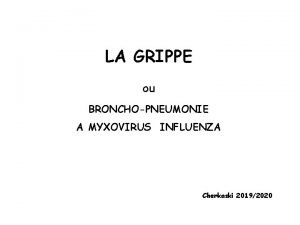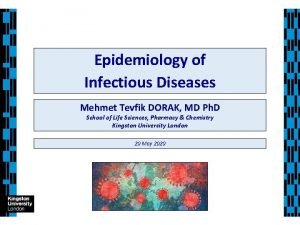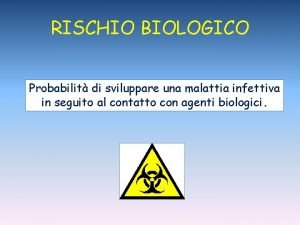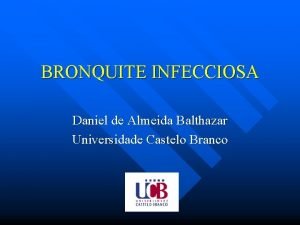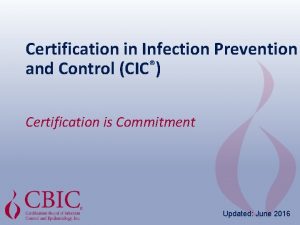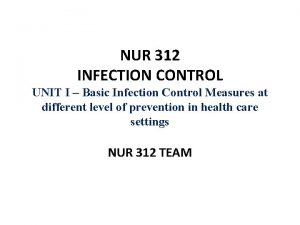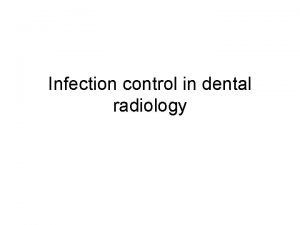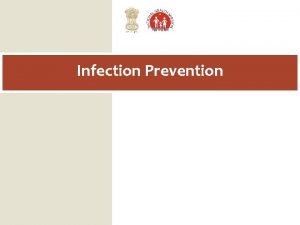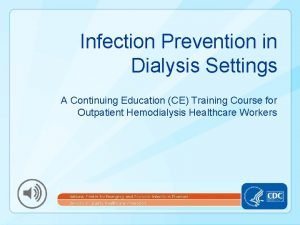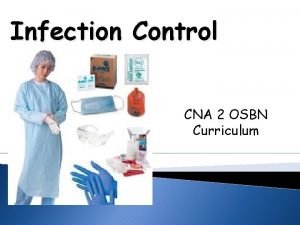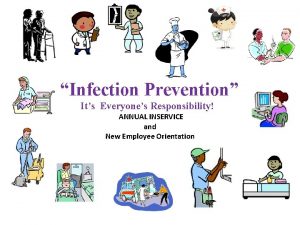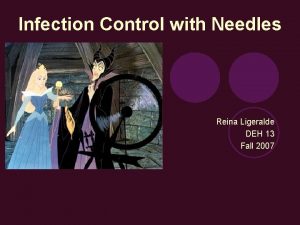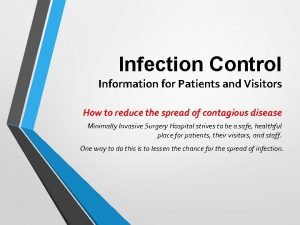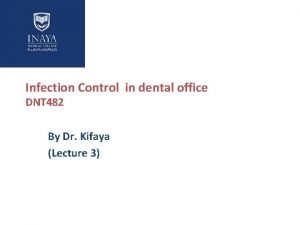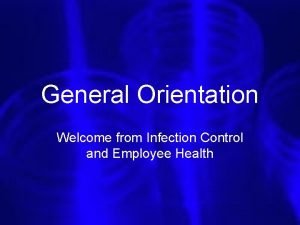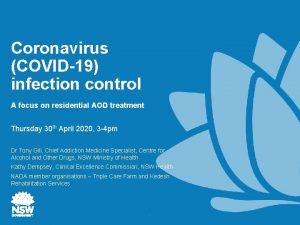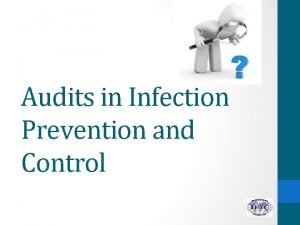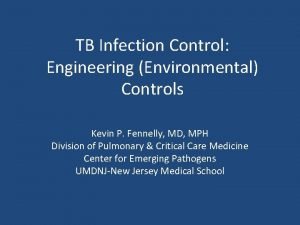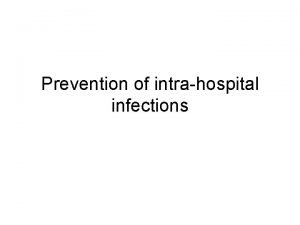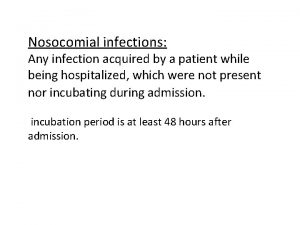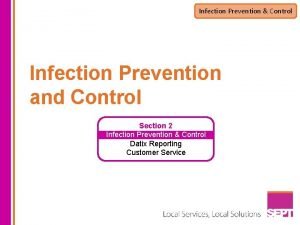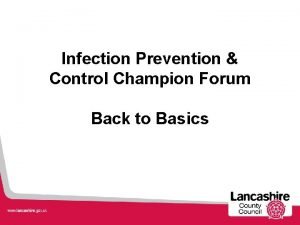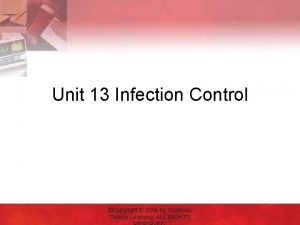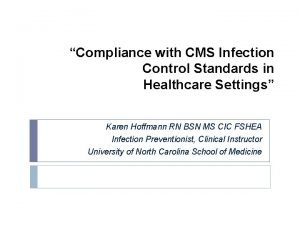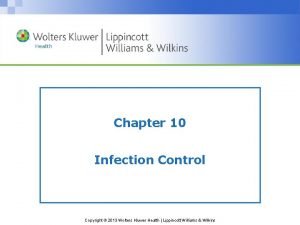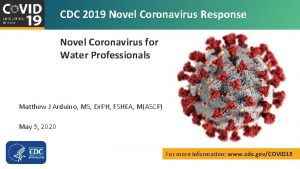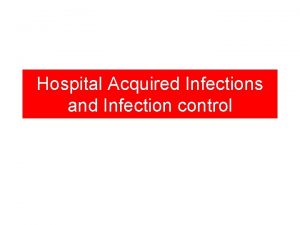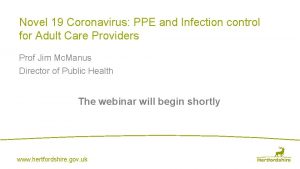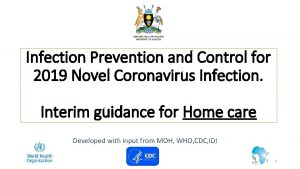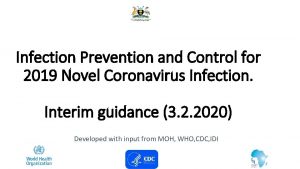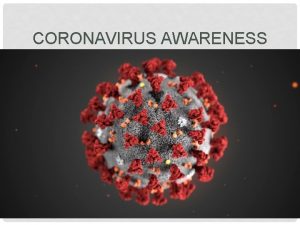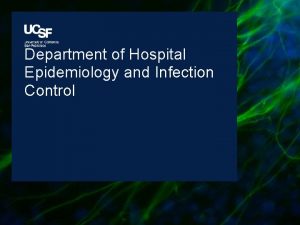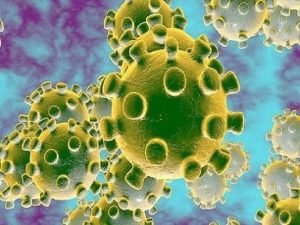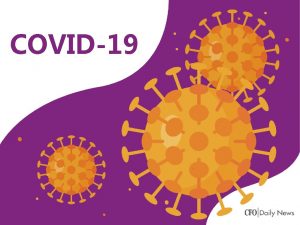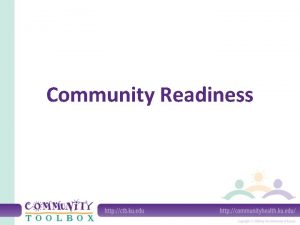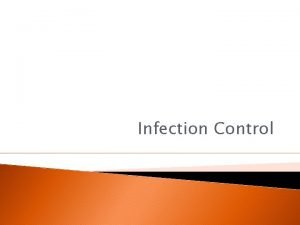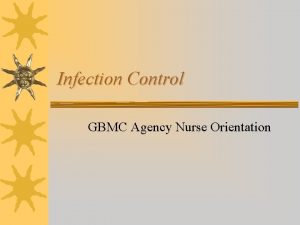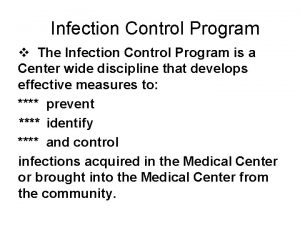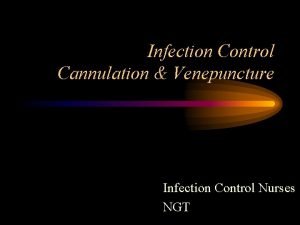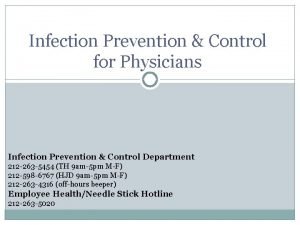Infection Control and Hospital Readiness Novel Coronavirus Dr







































- Slides: 39

Infection Control and Hospital Readiness- Novel Coronavirus Dr. Ritu Singh Chauhan, MD. NPO- International Health Regulations Team- Health Security and Emergencies WHO Country Office for India 29 Jan 2020

We are still learning about this virus, but hospitals need to be ready ? Incubation Period ? Period of Infectivity

Clinical care of suspected patients with 2019 -n. Co. V should focus on • Early recognition • Immediate isolation (separation) • Implementation of appropriate infection prevention and control (IPC) measures and • Provision of optimized supportive care.

Aims of Hospital Readiness • Prevent spread of 2019 -n. Co. V • Identify and isolate patients with 2019 -n. Co. V and inform key facility staff and public health authorities • Care for a limited number of patients with known or suspected 2019 n. Co. V- identified through entry screening • Potentially care for a larger number of patients in the context of escalating transmission • Outline plans for internal and external communication • Monitor and manage healthcare personnel with potential for exposure to 2019 n. Co. V • Manage the impact on patients, the facility, and healthcare personnel

Reference Document – for this presentation Infection prevention and control during health care when novel coronavirus (n. Co. V) infection is suspected WHO 2020 ( 25 January) Interim Guidance from WHO is based on current knowledge of the situation in China and other countries where cases were identified and experiences with severe acute respiratory syndrome (SARS)-Co. V and MERS-Co. V. WHO will update these recommendations as new information becomes available.

Advice on IPC for 2019 -n. Co. V : Generic Guidance Promotion of a safety climate is a cornerstone of prevention of transmission of pathogens in health care. Standard precautions should be the minimum level of precautions used when providing care for all patients. Risk assessment is critical. Assess all health-care activities to determine the personal protection that is indicated. Implement source control measures for all persons with respiratory symptoms through promotion of respiratory hygiene and cough etiquette.

Exact Modes of Transmission of 2019 -n. Co. V – not known

Hospitals- Need to review their IPC policy and strategy ( Slide 1 /2) All hospitals should have an IPC Programme with a dedicated and trained team or at least an IPC focal point in place and supported by senior management and health authority q q q q Assessment and triage of patients with acute respiratory symptoms Patient placement in isolation facility Implementation of Standard, Contact, and Airborne Precautions, including the use of eye protection Visitor management and exclusion Source control measures for patients (e. g. , put facemask on suspect patients) Requirements for performing aerosol generating procedures Be alert to case definitions and know how to report a potential 2019 -n. Co. V case

Hospitals- Need to review their IPC policy and strategy ( slide 2/2) q PPE available and staff trained in donning/ doffing q Provision for mechanical ventilation and ICU care q Protocol for environmental cleaning and disinfection q System for proper collection and disposal of contaminated medical waste q Policies to test and isolate any HCWs coming in contact with patients q An infection control team, responsible for monitoring daily activities and to follow up any exposed Health care worker

Use Standard Precautions at all Times It is not possible to always identify patients with novel coronavirus early or without testing because symptoms and other features may be very non specific. It is advisable to use Standard Precautions at all times, regardless. STANDARD PRECAUTIONS 1. 2. 3. 4. 5. 6. Promote a safety climate Hand Hygiene Wear PPE Source Control- Respiratory Hygiene and Cough Etiquette Environmental Management Injection Safety

Clinical Triage- Setting it up A system for assessing all patients at admission allowing early recognition of possible 2019 -n. Co. V infection and immediate isolation of patients with suspected n. Co. V infection in an area separate from other patients(source control). Healthcare facilities should: • Encourage HCWs to have a high level of clinical suspicion • Establish a well-equipped triage station at the entrance of health care facility, supported by trained staff • Institute the use of screening questionnaires according to the updated case definition https: //www. who. int/publications-detail/globalsurveillance-for-human-infection-with-novelcoronavirus-(2019 -ncov) • Post signs in public areas reminding symptomatic patients to alert HCWs.

Promote Hand Hygiene Everyone in the health care environment must practice good hand hygiene, including all health care providers, patients, visitors, and volunteers.

Effective Hand Washing

5 Moments of Hand Hygiene

Source Control Measures : Respiratory Hygiene and Cough Etiquette

Personal Protective Equipment (PPE) The rational, correct, and consistent use of PPE also helps to reduce the spread of pathogens. • Adequate and regular supplies • Adequate staff training • Appropriate hand hygiene and • Appropriate human behavior.

Practice donning and Doffing PPE



The Order of Removal of PPE is Critical

How to Remove Gowns ? ?

How to Remove Gloves ? ?

How to Remove Mask ? ?

Who should wear protective clothing ? All doctors, nurses, and health workers who provide direct patient care to suspected n. Co. V patients. All support staff who clean the isolation room, handle contaminated supplies and equipment, launder re-usable supplies, and collect and dispose of infectious waste All laboratory staff who handle patient specimens and body fluids from suspected n. Co. V cases. Laboratory support staff who clean and disinfect laboratory equipment used to test specimens. Burial teams who remove bodies of deceased patients and prepare them for burial/ Cremation. Family members who care for n. Co. V patients.

Patient Placement In addition to using standard precautions, all individuals, including family members, visitors and HCWs, should use contact and droplet precautions before entering the room where suspected or confirmed n. Co. V patients are admitted Patients should be placed in adequately ventilated single rooms For general ward rooms with natural ventilation, adequate ventilation is considered to be 60 L/s per patient when single rooms are not available, patients suspected of being infected with n. Co. V should be grouped together all patients’ beds should be placed at least 1 m apart regardless of whether they are suspected to have n. Co. V infection where possible, a team of HCWs should be designated to care exclusively for suspected or confirmed cases to reduce the risk of transmission limit the number of HCWs, family members and visitors who are in contact with a suspected and confirmed 2019 -n. Co. V patient maintain a record of all persons entering the patient’s room, including all staff and visitors

Contact Precautions- Direct Transmission This occurs when infectious agents are transferred from one person to another without a contaminated intermediate object or person. For example, blood or other body substances from an infectious person may come into contact with a mucous membrane or breaks in the skin of another person.

Contact Precautions--Indirect transmission This involves the transfer of an infectious agent through a contaminated intermediate object (fomite) or person. These include: Ø Ø Hands of HCWs Clothing after care of a patient colonized or infected with an infectious agent which can then be transmitted to subsequent patients; Patient-care devices that are shared between patients without cleaning and disinfection; and Environmental surfaces that are inadequately disinfected.

Additional PPE Requirements ( for Contact, Droplet precautions) HCWs should use a medical mask HCWs should wear eye protection (googles) or facial protection (face shield) to avoid contamination of mucous membranes HCWs should wear a clean, non-sterile, long-sleeved gown HCWs should also use gloves The use of boots, coverall and apron is not required during routine care After patient care, appropriate doffing and disposal of all PPE's and hygiene should be carried out Also, a new set of PPE's is needed, when care is given to a different patient HCWs should refrain from touching eyes, nose or mouth with potentially contaminated gloved or bare hands

Contact Precautions (Prevent infection through direct or indirect contact with patients or patient care environment ) Taken in addition to Standard Precautions Negative Pressure Isolation Room Limit patient movement Isolate or cohort patients Gown + gloves for patient / room contact Remove immediately after contact Do not touch eyes, nose, mouth with hands Avoid contaminating environmental surfaces

Contact Precautions Wash hands immediately after patient contact Equipment should be either single-use and disposable or dedicated equipment (e. g. , stethoscopes, blood pressure cuffs and thermometers) If Equipment needs to be shared, among patients, clean and disinfect it between use for each individual patient (e. g. , by using ethyl alcohol 70%) Clean, then disinfect patient room daily, frequent cleaning and disinfection with a focus on frequently-touched surfaces and equipment in the immediate vicinity of the patient. ( eg. -Bed rails, Bedside tables, Lavatory surfaces, Blood pressure cuff, equipment surfaces )

Transfer of patients with suspected n. Co. V should be kept to minimum. Ambulance crew and staff for the transfer should be informed of the patient’s clinical condition, and advised of appropriate precautions. Use appropriate PPE during the transfer. The used vehicle should be decontaminated after patient transportation. Contaminated items and equipment should be properly disinfected or discarded. Inform the receiving parties prior to transfer of patients to facilitate appropriate arrangement.

Airborne precautions for aerosol-generating procedures Some aerosol-generating procedures have been associated with an increased risk of transmission of coronaviruses (SARS-Co. V and MERS-Co. V), such as tracheal intubation, non-invasive ventilation, tracheotomy, cardiopulmonary resuscitation, manual ventilation before intubation, and bronchoscopy. P Procedures only in an adequately ventilated room using full PPE ( N 95 mask) that is, natural ventilation with air flow of at least 160 L/s per patient or in negative pressure rooms with at least 12 air changes per hour and controlled direction of air flow when using mechanical ventilation use eye protection (i. e. , goggles or a face shield), wear a clean, non-sterile, long-sleeved gown and gloves. If gowns are not fluid resistant, HCWs should use a waterproof apron for Infection prevention and control during health care when novel coronavirus (n. Co. V) infection is suspected Limit the number of persons present in the room to the absolute minimum required for the patient’s care and support.

Environmental Controls Ensure that cleaning and disinfection procedures are followed consistently and correctly. Cleaning environmental surfaces with water and detergent and applying commonly used hospital disinfectants (such as sodium hypochlorite) is an effective and sufficient procedure. Cleaning should always be carried out from “clean” areas to “dirty” areas, in order to avoid contaminant transfer. Manage laundry, food service utensils and medical waste in accordance with safe routine procedures.

Cleaning and Disinfection of the environment Floors and horizontal work surfaces should be cleaned at least once/twice a day. Dry sweeping with a broom should never be done. Cleaning with a moistened cloth helps to avoid contaminating the air with airborne particles. Clean before you disinfect. Change cleaning solutions and equipment frequently, as these items will get contaminated quickly (follow your hospital protocols).

Use of disinfectants Bleach (sodium hypochlorite) 1% for disinfection of material contaminated with body fluids Several concentrations may be marketed (e. g. , 2. 5%, 5%) q. If 5% solution available, mix 1 part 5% solution with 5 parts clean water q. If 2. 5% solution available, mix 2 parts 2. 5% solution with 5 parts clean water Clean and disinfect patient areas daily, with particular attention to frequently touched surfaces – counter tops, door handles, medical equipment. Use bleaching powder (7 g/1 L water ie 70% available chlorine) for disinfection of toilets/bathrooms

Administrative Measures Ø Ø Ø Train and educate Health care workers on strict adherence to IPC Dedicated and assigned HCWs Monitoring of health of HCWs PPE stock management Strict Visitor Policy Patient’s relatives/ attendants should be educated on mode of transmission, hand hygiene and PPE

All specimens for lab investigations- Potentially infectious Ensure that HCWs who collect specimens use appropriate PPE All personnel who transport specimens need to be trained in safe handling practices and spill decontamination procedures Place specimens for transport in leak-proof specimen bags (i. e. , secondary containers) that have a separate sealable pocket for the specimen (i. e. , a plastic biohazard specimen bag), with the patient’s label on the specimen container (i. e. , the primary container), and a clearly written laboratory request form Deliver all specimens by hand whenever possible Document clearly each patient’s full name, date of birth and suspected n. Co. V of potential concern on the laboratory request form. Notify the laboratory as soon as possible that the specimen is being transported.

WHO recommends a multimodal strategy for IPC activities to improve practices and reduce Hospital associated Infections (HAIs) National Guidelines for Infection prevention and Control

For Further Details, please refer Infection prevention and control during health care when novel coronavirus (n. Co. V) infection is suspected WHO Interim guidance 25 January 2020 | Publication National Guidelines for Infection Prevention and Control in Healthcare Facilities, Ministry of Health and Family Welfare, Government of India
 Scissurite coronavirus
Scissurite coronavirus Relazione finale classe terza primaria
Relazione finale classe terza primaria Coronavirus
Coronavirus 3 elementos abióticos
3 elementos abióticos Rischio biologico coronavirus | titolo x d.lgs. 81/08
Rischio biologico coronavirus | titolo x d.lgs. 81/08 Allegato xlvi del d.lgs. 81/08 coronavirus
Allegato xlvi del d.lgs. 81/08 coronavirus Bronquite coronavirus
Bronquite coronavirus Turbt full form
Turbt full form Chapter 16 infection control and standard precautions
Chapter 16 infection control and standard precautions Chapter 16 infection control and standard precautions
Chapter 16 infection control and standard precautions State regulatory agencies milady
State regulatory agencies milady Certification board of infection control and epidemiology
Certification board of infection control and epidemiology History of dental radiology ppt
History of dental radiology ppt Chapter 15:9 maintaining transmission based precautions
Chapter 15:9 maintaining transmission based precautions Chapter 15:4 observing standard precautions
Chapter 15:4 observing standard precautions Cic certification exam
Cic certification exam Infection control definition
Infection control definition Darkroom infection control guidelines
Darkroom infection control guidelines Learning objectives for infection control
Learning objectives for infection control Conclusion of infection
Conclusion of infection Cna infection control
Cna infection control Infection control is everyone's responsibility
Infection control is everyone's responsibility Infection control
Infection control Aseptic technique nsw health
Aseptic technique nsw health Infection control information
Infection control information Root locus drawer
Root locus drawer Infection control orientation
Infection control orientation Infection control
Infection control Infection control audits
Infection control audits Environmental controls infection control
Environmental controls infection control Another name for customer service
Another name for customer service Infection control committee
Infection control committee Conclusion of infection control
Conclusion of infection control 10 principles of infection control
10 principles of infection control Infection control champion
Infection control champion Unit 13 infection control
Unit 13 infection control Infection control surveyor worksheet
Infection control surveyor worksheet Chapter 10 infection control
Chapter 10 infection control Hospital pharmacy definition
Hospital pharmacy definition Chapter 19 disease transmission and infection prevention
Chapter 19 disease transmission and infection prevention
